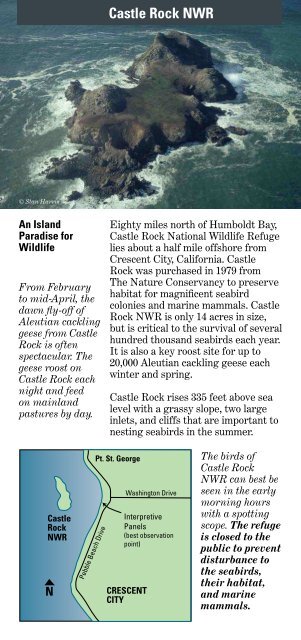Humboldt Bay - U.S. Fish and Wildlife Service
Humboldt Bay - U.S. Fish and Wildlife Service
Humboldt Bay - U.S. Fish and Wildlife Service
Create successful ePaper yourself
Turn your PDF publications into a flip-book with our unique Google optimized e-Paper software.
© Stan Harris<br />
An Isl<strong>and</strong><br />
Paradise for<br />
<strong>Wildlife</strong><br />
From February<br />
to mid-April, the<br />
dawn fy-off of<br />
Aleutian cackling<br />
geese from Castle<br />
Rock is often<br />
spectacular. The<br />
geese roost on<br />
Castle Rock each<br />
night <strong>and</strong> feed<br />
on mainl<strong>and</strong><br />
pastures by day.<br />
Castle<br />
Rock<br />
NWR<br />
N<br />
Castle Rock NWR<br />
Eighty miles north of <strong>Humboldt</strong> <strong>Bay</strong>,<br />
Castle Rock National <strong>Wildlife</strong> Refuge<br />
lies about a half mile offshore from<br />
Crescent City, California. Castle<br />
Rock was purchased in 1979 from<br />
The Nature Conservancy to preserve<br />
habitat for magnifcent seabird<br />
colonies <strong>and</strong> marine mammals. Castle<br />
Rock NWR is only 14 acres in size,<br />
but is critical to the survival of several<br />
hundred thous<strong>and</strong> seabirds each year.<br />
It is also a key roost site for up to<br />
20,000 Aleutian cackling geese each<br />
winter <strong>and</strong> spring.<br />
Castle Rock rises 335 feet above sea<br />
level with a grassy slope, two large<br />
inlets, <strong>and</strong> cliffs that are important to<br />
nesting seabirds in the summer.<br />
Pt. St. George<br />
Pebble Beach Drive<br />
Washington Drive<br />
Interpretive<br />
Panels<br />
(best observation<br />
point)<br />
CRESCENT<br />
CITY<br />
The birds of<br />
Castle Rock<br />
NWR can best be<br />
seen in the early<br />
morning hours<br />
with a spotting<br />
scope. The refuge<br />
is closed to the<br />
public to prevent<br />
disturbance to<br />
the seabirds,<br />
their habitat,<br />
<strong>and</strong> marine<br />
mammals.<br />
Did You Know?<br />
Castle Rock<br />
NWR <strong>and</strong><br />
northcoast<br />
ranchers played<br />
a critical role in<br />
the recovery of<br />
Aleutian cackling<br />
geese, one of<br />
the signatory<br />
successes of the<br />
Endangered<br />
Species Act.<br />
Fully delisted<br />
in 2001, this<br />
population has<br />
grown from fewer<br />
than 800 birds<br />
in 1974 to more<br />
than 100,000 in<br />
2006.<br />
Harbor seals<br />
haul out on<br />
Castle Rock<br />
NWR.<br />
© Tupper Ansel Blake<br />
During April–<br />
May the clownlike<br />
tufted puffns<br />
may be seen.<br />
© Jesse Irwin<br />
The cliffs provide nesting habitat<br />
for one of the largest breeding<br />
populations (100,000) of common<br />
murres on the Pacifc coast. Ten other<br />
species of seabirds also nest here,<br />
including three species of cormorants,<br />
pigeon guillemots, Cassin’s <strong>and</strong><br />
rhinoceros auklets, Leach’s <strong>and</strong><br />
fork-tailed storm-petrels, <strong>and</strong> tufted<br />
puffns. Because many of these bird<br />
species nest in burrows <strong>and</strong> crevices<br />
<strong>and</strong> are primarily nocturnal, they<br />
avoid predation by western gulls that<br />
also nest on the isl<strong>and</strong>.<br />
Castle Rock NWR also serves as an<br />
important haul out (resting site) for<br />
marine mammals, including harbor<br />
seals, northern elephant seals (both<br />
bear pups there), <strong>and</strong> California <strong>and</strong><br />
Steller sea lions.

















